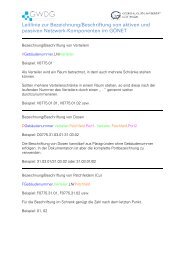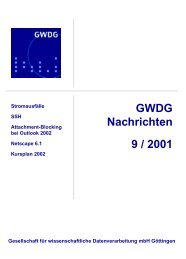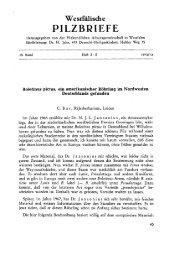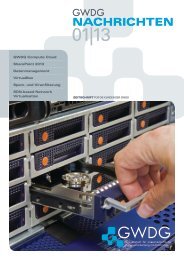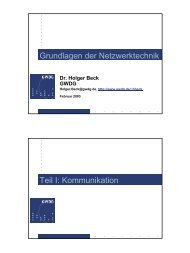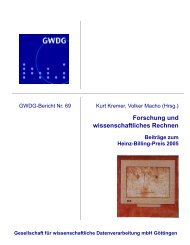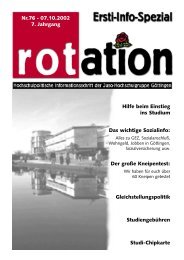Create successful ePaper yourself
Turn your PDF publications into a flip-book with our unique Google optimized e-Paper software.
<strong>Cognate</strong> <strong>Objects</strong> <strong>in</strong> <strong>English</strong><br />
Manfred Sailer<br />
Universität Gött<strong>in</strong>gen<br />
HPSG 2010<br />
Manfred Sailer (Gött<strong>in</strong>gen) <strong>Cognate</strong> <strong>Objects</strong> HPSG 2010 1 / 39
Outl<strong>in</strong>e<br />
1 Introduction<br />
2 The Syntactic Status of <strong>Cognate</strong> <strong>Objects</strong><br />
3 The Interpretation of <strong>Cognate</strong> <strong>Objects</strong><br />
4 Analysis<br />
Lexical Resource Semantics (LRS)<br />
Concrete Event COs<br />
Other Types of COs<br />
5 Summary and Outlook<br />
Manfred Sailer (Gött<strong>in</strong>gen) <strong>Cognate</strong> <strong>Objects</strong> HPSG 2010 2 / 39
Term<strong>in</strong>ology<br />
<strong>Cognate</strong> objects construction (COC): verb cognate object (CO)<br />
(1) a. fight a good fight<br />
b. sleep the sleep of the just<br />
Morphological-semantic criterion: Sweet (1891): The noun<br />
repeats the mean<strong>in</strong>g of the verb and has the same stem.<br />
Verb class: unergative, <strong>in</strong>transitive verbs (+ die)<br />
Selectional restriction: Jones (1988): The verb is normally<br />
<strong>in</strong>transitive; little variation <strong>in</strong> what could occur as an accusative<br />
(2) a. Sam lived a happy life/ *someth<strong>in</strong>g happy.<br />
b. Sam died a gruesome death/ *a murder.<br />
c. Sam danced a dance/ a jig/ a piece from Swan Lake.<br />
d. Sam dreamed a nice dream/ someth<strong>in</strong>g funny.<br />
Manfred Sailer (Gött<strong>in</strong>gen) <strong>Cognate</strong> <strong>Objects</strong> HPSG 2010 3 / 39
Problems<br />
syntactic status of the cognate object (complement/ adjunct)<br />
<strong>in</strong>terpretation of the cognate object (event/ object)<br />
“cognateness” of verb and head noun<br />
Manfred Sailer (Gött<strong>in</strong>gen) <strong>Cognate</strong> <strong>Objects</strong> HPSG 2010 4 / 39
Outl<strong>in</strong>e<br />
1 Introduction<br />
2 The Syntactic Status of <strong>Cognate</strong> <strong>Objects</strong><br />
3 The Interpretation of <strong>Cognate</strong> <strong>Objects</strong><br />
4 Analysis<br />
Lexical Resource Semantics (LRS)<br />
Concrete Event COs<br />
Other Types of COs<br />
5 Summary and Outlook<br />
Manfred Sailer (Gött<strong>in</strong>gen) <strong>Cognate</strong> <strong>Objects</strong> HPSG 2010 5 / 39
Outl<strong>in</strong>e<br />
1 Introduction<br />
2 The Syntactic Status of <strong>Cognate</strong> <strong>Objects</strong><br />
3 The Interpretation of <strong>Cognate</strong> <strong>Objects</strong><br />
4 Analysis<br />
Lexical Resource Semantics (LRS)<br />
Concrete Event COs<br />
Other Types of COs<br />
5 Summary and Outlook<br />
Manfred Sailer (Gött<strong>in</strong>gen) <strong>Cognate</strong> <strong>Objects</strong> HPSG 2010 6 / 39
Properties from Jones (1988)<br />
passivization: *[A silly smile] was smiled.<br />
topicalization: *[A silly smile], nobody smiled.<br />
pronom<strong>in</strong>alization:<br />
*Maggie smiled [a silly smile]i and then her brother smiled iti.<br />
def<strong>in</strong>iteness restriction:<br />
*He smiled [the smile for which he was famous].<br />
question<strong>in</strong>g: *What did he die?<br />
obligatory modification: ?He died [a death].<br />
required cognateness: *He died [a suicide]/ [a murder].<br />
manner paraphrase:<br />
Bill sighed [a weary sigh] = Bill sighed wearily.<br />
Manfred Sailer (Gött<strong>in</strong>gen) <strong>Cognate</strong> <strong>Objects</strong> HPSG 2010 7 / 39
COs as Adjuncts (Jones, 1988; Moltmann, 1989)<br />
passivization (ok): *[A silly smile] was smiled.<br />
def<strong>in</strong>iteness restriction (unclear):<br />
*He smiled [the smile for which he was famous].<br />
obligatory modification (unclear): ?He died [a death].<br />
required cognateness (unclear): *He died [a suicide]/ [a murder].<br />
manner paraphrase (ok):<br />
Billed sighed [a weary smile] = Bill sighed wearily.<br />
Manfred Sailer (Gött<strong>in</strong>gen) <strong>Cognate</strong> <strong>Objects</strong> HPSG 2010 8 / 39
Problems for the Adjunct Analysis<br />
Massam (1990); Macfarland (1995); Kuno and Takami (2004)<br />
passivization: [A smile] was smiled somewhere.<br />
def<strong>in</strong>iteness restriction: Pat slept [the sleep of the just].<br />
obligatory modification: You’ve got to live [your life], too. (BNC)<br />
required cognateness:<br />
Van Ald<strong>in</strong> laughed [a quiet little cackle of amusement].<br />
manner paraphrase:<br />
She laughed [a little laugh] <strong>in</strong> her throat, but didn’t answer.<br />
restriction to <strong>in</strong>transitive verbs:<br />
(3) They fought [a heroic fight].<br />
They fought the enemy heroically/ *[a heroic fight].<br />
In <strong>English</strong>: <strong>Cognate</strong> objects are complements.<br />
Manfred Sailer (Gött<strong>in</strong>gen) <strong>Cognate</strong> <strong>Objects</strong> HPSG 2010 9 / 39
Different Syntactic Patterns<br />
3 prototypical patterns:<br />
◮ <strong>in</strong>def<strong>in</strong>ite pattern: verb [a/an Adj CO]<br />
Pat lived [a happy life].<br />
◮ def<strong>in</strong>ite pattern: verb [the (Adj) CO PP]<br />
Pat lived [the tranquil life of a Buddhist monk].<br />
Pat smiled [the smile of reassurance].<br />
◮ possessive pattern: verb [Poss (Adj) CO]<br />
Pat lived [his secret life].<br />
<strong>in</strong>def<strong>in</strong>ite pattern: shows the Jones properties<br />
other patterns: syntactically more flexible<br />
Manfred Sailer (Gött<strong>in</strong>gen) <strong>Cognate</strong> <strong>Objects</strong> HPSG 2010 10 / 39
Empirical Justification for the Patterns<br />
Höche (2009): usage data<br />
British National Corpus (BNC); 400 verbs; over 3,000 sentences<br />
with a potential COC.<br />
<strong>in</strong>def<strong>in</strong>ite vs. other patterns: 33.4% of the COCs without modifier;<br />
64% thereof def<strong>in</strong>ite (Höche, 2009, p. 209ff)<br />
Type of modifier (Höche, p.c.)<br />
<strong>in</strong>def<strong>in</strong>ite vs. def<strong>in</strong>ite pattern:<br />
PP : Adjektiv<br />
COs with the: 164 : 174<br />
COs with a/an: 137 : 788 (significant preferance for Adj)<br />
passive:<br />
almost all examples <strong>in</strong> Höche (2009) def<strong>in</strong>ite;<br />
all examples <strong>in</strong> Kuno and Takami (2004) without modifier.<br />
Manfred Sailer (Gött<strong>in</strong>gen) <strong>Cognate</strong> <strong>Objects</strong> HPSG 2010 11 / 39
Summary: Syntactic Status<br />
All COs are complements<br />
We can identify prototypical syntactic patterns for COCs, <strong>in</strong><br />
particular the <strong>in</strong>def<strong>in</strong>ite pattern.<br />
The cluster of properties from Jones (1988) is real, but restricted<br />
to a subclass of COCs.<br />
Manfred Sailer (Gött<strong>in</strong>gen) <strong>Cognate</strong> <strong>Objects</strong> HPSG 2010 12 / 39
Outl<strong>in</strong>e<br />
1 Introduction<br />
2 The Syntactic Status of <strong>Cognate</strong> <strong>Objects</strong><br />
3 The Interpretation of <strong>Cognate</strong> <strong>Objects</strong><br />
4 Analysis<br />
Lexical Resource Semantics (LRS)<br />
Concrete Event COs<br />
Other Types of COs<br />
5 Summary and Outlook<br />
Manfred Sailer (Gött<strong>in</strong>gen) <strong>Cognate</strong> <strong>Objects</strong> HPSG 2010 13 / 39
Events or <strong>Objects</strong><br />
previous appraoches<br />
◮ COs are <strong>in</strong>terpreted as events, coreferent with the event of the ma<strong>in</strong><br />
verb.<br />
Jones (1988); Moltmann (1989); Massam (1990); Huddleston and<br />
Pullum (2002)<br />
◮ COs are <strong>in</strong>terpreted as resultant/ effected objects.<br />
Quirk et al. (1985); Macfarland (1995); Kuno and Takami (2004)<br />
extended synthesis of the approaches:<br />
◮ Both approaches are needed, but with different prototypical<br />
patterns<br />
◮ additional dimension:<br />
concrete/particular vs. abstract/generic read<strong>in</strong>gs<br />
Manfred Sailer (Gött<strong>in</strong>gen) <strong>Cognate</strong> <strong>Objects</strong> HPSG 2010 14 / 39
Events or <strong>Objects</strong><br />
event effected object<br />
concrete/ <strong>in</strong>def<strong>in</strong>ite pattern def. or <strong>in</strong>def. pattern<br />
particular direct object direct object<br />
abstract/ def<strong>in</strong>ite pattern def. or possessive pattern<br />
generic direct object direct object<br />
(4) Event read<strong>in</strong>gs:<br />
a. concrete/particular:<br />
But the smile lasted less than a heartbeat. (BNC)<br />
b. abstract/generic:<br />
I couldn’t stop [the silly smile of surprise] (www)<br />
(5) Object read<strong>in</strong>gs:<br />
a. concrete/particular:<br />
[A smile] appeared on his face. (BNC)<br />
b. abstract/generic:<br />
No wonder Button wore [the smile of a lucky man]. (www)<br />
Manfred Sailer (Gött<strong>in</strong>gen) <strong>Cognate</strong> <strong>Objects</strong> HPSG 2010 15 / 39
COs as Concrete Events<br />
event object<br />
concrete !<br />
abstract<br />
(6) Harry lived [a happy life]. = Harry lived happily.<br />
Jones’ properties:<br />
◮ manner paraphrase<br />
◮ <strong>in</strong>def<strong>in</strong>ite NP<br />
◮ no passive<br />
◮ obligatory modification<br />
Analysis (Moltmann, 1989; Mittwoch, 1998):<br />
◮ CO and verb refer to the same eventuality.<br />
◮ bound by the same existential quantifier → <strong>in</strong>def<strong>in</strong>ite<br />
Potential problems for a complement analysis:<br />
◮ passive<br />
◮ obligatory modification<br />
Manfred Sailer (Gött<strong>in</strong>gen) <strong>Cognate</strong> <strong>Objects</strong> HPSG 2010 16 / 39
The Other CO Types I<br />
event object<br />
concrete ! !<br />
abstract ! !<br />
(7) a. [The last laugh] has now been laughed. (concrete object)<br />
b. Sachs smiled [his irresistible smile] (abstract object)<br />
c. I slept [the sleep of the just]. (abstract event)<br />
none of Jones’ properties:<br />
◮ manner paraphrase not obvious<br />
◮ typically not an <strong>in</strong>def<strong>in</strong>ite NP<br />
◮ passive possible<br />
◮ modification not neccessary<br />
Analysis<br />
◮ CO <strong>in</strong>troduces its own <strong>in</strong>dex<br />
◮ relation between the verb and the CO as effected object (Kuno and<br />
Takami, 2004) or <strong>in</strong>stantiation<br />
◮ passivizability and optionality of modifier follow directly<br />
Manfred Sailer (Gött<strong>in</strong>gen) <strong>Cognate</strong> <strong>Objects</strong> HPSG 2010 17 / 39
The Other CO Types II<br />
event object<br />
concrete ! !<br />
abstract ! !<br />
(8) a. [The last laugh] has now been laughed. (concrete object)<br />
b. Sachs smiled [his irresistible smile] (abstract object)<br />
c. I slept [the sleep of the just]. (abstract event)<br />
concrete object: CO refers to an <strong>in</strong>dependent entity that is brought<br />
<strong>in</strong>to existence by the verb.<br />
abstract object: The event has an effected object which is an<br />
<strong>in</strong>stantiation of the k<strong>in</strong>d expressed <strong>in</strong> the CO.<br />
abstract event: The event is an <strong>in</strong>stance of the abstract event<br />
(event type) expressed <strong>in</strong> the CO.<br />
Manfred Sailer (Gött<strong>in</strong>gen) <strong>Cognate</strong> <strong>Objects</strong> HPSG 2010 18 / 39
Summary: Interpretation of COs<br />
four different <strong>in</strong>terpretations of the CO<br />
<strong>in</strong>terpretations <strong>in</strong>dependently attested <strong>in</strong> other constructions<br />
only the concrete event read<strong>in</strong>g has special syntactic properties<br />
Manfred Sailer (Gött<strong>in</strong>gen) <strong>Cognate</strong> <strong>Objects</strong> HPSG 2010 19 / 39
Outl<strong>in</strong>e<br />
1 Introduction<br />
2 The Syntactic Status of <strong>Cognate</strong> <strong>Objects</strong><br />
3 The Interpretation of <strong>Cognate</strong> <strong>Objects</strong><br />
4 Analysis<br />
Lexical Resource Semantics (LRS)<br />
Concrete Event COs<br />
Other Types of COs<br />
5 Summary and Outlook<br />
Manfred Sailer (Gött<strong>in</strong>gen) <strong>Cognate</strong> <strong>Objects</strong> HPSG 2010 20 / 39
Outl<strong>in</strong>e<br />
1 Introduction<br />
2 The Syntactic Status of <strong>Cognate</strong> <strong>Objects</strong><br />
3 The Interpretation of <strong>Cognate</strong> <strong>Objects</strong><br />
4 Analysis<br />
Lexical Resource Semantics (LRS)<br />
Concrete Event COs<br />
Other Types of COs<br />
5 Summary and Outlook<br />
Manfred Sailer (Gött<strong>in</strong>gen) <strong>Cognate</strong> <strong>Objects</strong> HPSG 2010 21 / 39
Underspecified Comb<strong>in</strong>atorial Semantics<br />
Unterspecified semantics (Reyle, 1993; P<strong>in</strong>kal, 1996; Egg, 2002;<br />
Kallmeyer and Romero, 2008)<br />
◮ scope relations are left underspecified<br />
◮ mean<strong>in</strong>g contribution: lists of partially specified expressions of a<br />
semantic representation language<br />
<strong>in</strong> HPSG: Frank and Reyle (1995); Egg (1998); Copestake et al.<br />
(1995, 2005)<br />
Lexical Resource Semantics (LRS)<br />
Richter and Sailer (2004)<br />
read<strong>in</strong>gs: semantic representations that conta<strong>in</strong> exactly the<br />
mean<strong>in</strong>g contributions of the elements <strong>in</strong> the sentence.<br />
constra<strong>in</strong>ts restrict possible read<strong>in</strong>gs<br />
Manfred Sailer (Gött<strong>in</strong>gen) <strong>Cognate</strong> <strong>Objects</strong> HPSG 2010 22 / 39
Comb<strong>in</strong>atorial Semantics of LRS<br />
Use of a standard semantic representation language<br />
Different words may contribute identical parts to the overall<br />
read<strong>in</strong>g.<br />
Identity of operators: question, negation, tense<br />
(9) Who had bought which book? (question)<br />
?-someone had bought ?-some book (Richter and Sailer, 1999)<br />
(10) Afrikaans:<br />
a. Niemand het niks gesê nie. (negation)<br />
nobody has noth<strong>in</strong>g said not (Richter and Sailer, 2006)<br />
(‘Nobody said anyth<strong>in</strong>g.’)<br />
b. Jan kon die boek gelees het. (tense)<br />
Jan could.Past the book read<br />
(‘Jan could read the book.’)<br />
have.Past (Sailer, 2004b)<br />
Manfred Sailer (Gött<strong>in</strong>gen) <strong>Cognate</strong> <strong>Objects</strong> HPSG 2010 23 / 39
Lexical Semantics <strong>in</strong> LRS<br />
Lexical-semantic properties (Sailer, 2004a):<br />
◮ referential <strong>in</strong>dex (INDEX)<br />
◮ core lexical contribution (MAIN)<br />
Sketch of the lexical entry of the verb smile:<br />
2 ˙ ¸<br />
PHON smile<br />
6 2 2<br />
3<br />
6<br />
CAT HEAD<br />
6<br />
verb<br />
6 6 6<br />
"<br />
#<br />
7<br />
6SYNSEM<br />
4LOC 4<br />
INDEX e 5<br />
6<br />
CONTENT<br />
6<br />
MAIN smile<br />
6 D<br />
6<br />
6ARG-ST<br />
NP<br />
6<br />
4<br />
ˆ LOC CONTENT INDEX x ˜E<br />
3<br />
7 constra<strong>in</strong>ts on<br />
7 the relation between<br />
7+<br />
7<br />
the semantic<br />
2<br />
3 7<br />
* ∃e(.. .),<br />
+ 7 contributions<br />
6<br />
7<br />
7<br />
LF 4PARTS . . . ∧ Agent(e,...),<br />
7<br />
5 5<br />
smile(e)<br />
COC: identical lexical semantic contributions:<br />
(11) Pat smiled [a happy smile]. (COC)<br />
(‘Pat smiled happily.’)<br />
Manfred Sailer (Gött<strong>in</strong>gen) <strong>Cognate</strong> <strong>Objects</strong> HPSG 2010 24 / 39
Syntactic Analysis of the COC<br />
All COs are direct objects<br />
COC Lexical Rule: <strong>in</strong>transitive verb ↦→ transitive verb (general<br />
version)<br />
<strong>Cognate</strong>ness: identity of core lexical contributions (MAIN value)<br />
2<br />
4 SYNSEM<br />
h ˆ ˜<br />
LOC CAT HEAD verb i<br />
2 " " ##<br />
3<br />
CAT HEAD verb<br />
6SYNSEM<br />
LOC<br />
ˆ ˜<br />
˙ ¸<br />
5↦→6<br />
CONTENT MAIN 1<br />
4 D h<br />
ARG-ST 1 ˆ ˜<br />
ARG-ST 1 , NP LOC CONTENT MAIN 1 iE<br />
3<br />
7<br />
5<br />
syntactic structure:<br />
V<br />
smiled<br />
↑<br />
coc-lexrule<br />
|<br />
smile<br />
Det<br />
a<br />
VP<br />
NP<br />
AP<br />
happy<br />
N ′<br />
N<br />
smile<br />
Manfred Sailer (Gött<strong>in</strong>gen) <strong>Cognate</strong> <strong>Objects</strong> HPSG 2010 25 / 39
Outl<strong>in</strong>e<br />
1 Introduction<br />
2 The Syntactic Status of <strong>Cognate</strong> <strong>Objects</strong><br />
3 The Interpretation of <strong>Cognate</strong> <strong>Objects</strong><br />
4 Analysis<br />
Lexical Resource Semantics (LRS)<br />
Concrete Event COs<br />
Other Types of COs<br />
5 Summary and Outlook<br />
Manfred Sailer (Gött<strong>in</strong>gen) <strong>Cognate</strong> <strong>Objects</strong> HPSG 2010 26 / 39
Concrete Event COs<br />
event semantics (Parsons, 1990) applied to COs (Moltmann,<br />
1989):<br />
(12) semantics<br />
a. She smiled.<br />
∃e(smile(e) ∧ Agent(e, x))<br />
b. Pat smiled [a happy smile].<br />
= Pat smiled happily.<br />
∃e(smile(e) ∧ happy(e) ∧ Agent(e, x))<br />
verb and cognate object:<br />
◮ identical referential <strong>in</strong>dex (INDEX): e<br />
◮ identical core lexical semantic contribution (MAIN): smile<br />
Manfred Sailer (Gött<strong>in</strong>gen) <strong>Cognate</strong> <strong>Objects</strong> HPSG 2010 27 / 39
Lexical Rule<br />
Concrete Event COC Lexical Rule:<br />
2 2<br />
HEAD verb<br />
6<br />
6<br />
"<br />
SYNSEM<br />
6<br />
4<br />
INDEX<br />
CONTENT<br />
6<br />
4<br />
MAIN<br />
˙ ¸<br />
ARG-ST 3<br />
3<br />
#<br />
7<br />
1 5 7<br />
2 7<br />
5 ↦→<br />
2 2<br />
3<br />
HEAD verb<br />
6 6<br />
" #<br />
7<br />
6SYNSEM<br />
4<br />
INDEX 1 5<br />
6<br />
CONTENT<br />
6<br />
MAIN<br />
6<br />
2<br />
6<br />
2<br />
6 * HEAD noun<br />
6<br />
6<br />
"<br />
4ARG-ST<br />
3 , NP 4<br />
INDEX<br />
CONTENT<br />
MAIN<br />
3<br />
7<br />
3 7<br />
+ 7<br />
# 7<br />
7 7<br />
1 5 5<br />
2<br />
More specific version of the COC Lexical Rule<br />
Input: <strong>in</strong>transitive, (atelic) verb<br />
Output:<br />
◮ additional NP complement<br />
◮ Verb and NP complement have identical INDEX and MAIN values.<br />
Manfred Sailer (Gött<strong>in</strong>gen) <strong>Cognate</strong> <strong>Objects</strong> HPSG 2010 28 / 39
Output of the Concrete Event COC Lex Rule:<br />
2 ˙ ¸<br />
PHON smiled<br />
6 2 2<br />
3<br />
6<br />
CAT HEAD verb<br />
6 6 6<br />
"<br />
#<br />
7<br />
6SYNSEM<br />
4LOC 4<br />
INDEX 1 e 5<br />
6<br />
CONTENT<br />
6<br />
MAIN 2 smile<br />
6 *<br />
6<br />
6ARG-ST<br />
NP<br />
6<br />
4<br />
ˆ SYNS LOC CONT INDEX x ˜ 2<br />
3<br />
HEAD noun +<br />
6<br />
" #<br />
7<br />
, NP 4<br />
INDEX 1 5<br />
CONTENT<br />
MAIN 2<br />
2<br />
* ∃e(. . .),<br />
+<br />
6<br />
LF 4PARTS . . . ∧ Agent(e,...),<br />
smile(e)<br />
3<br />
3<br />
7<br />
7<br />
7<br />
5<br />
5<br />
concrete event read<strong>in</strong>g of the CO: INDEX identity<br />
cognateness of verb and complement noun: MAIN identity<br />
obligatory modification?<br />
no passive?<br />
Manfred Sailer (Gött<strong>in</strong>gen) <strong>Cognate</strong> <strong>Objects</strong> HPSG 2010 29 / 39
Obligatory Modification I<br />
PRINCIPLE OF SEMANTIC DISCERNIBILITY:<br />
In a phrase, the mean<strong>in</strong>g contributions of one daughter may not be a<br />
non-empty subset of the mean<strong>in</strong>g contributions of another daughter.<br />
(13) She [VP2 [VP1 smiled happily1] happily2].<br />
= ∃e(smile(e) ∧ Agent(e, x) ∧ happy(e))<br />
smiled: ∃e( smile(e) ∧ Ag(e, ) )<br />
happily1: ∧happy(e)<br />
VP1: ∃e( smile(e) ∧ Ag(e, ) ∧happy(e) )<br />
happily2: ∧happy(e)<br />
* VP2: ∃e( smile(e) ∧ Ag(e, ) ∧happy(e) )<br />
She: x<br />
∃e( smile(e) ∧ Ag(e, x ) ∧happy(e) )<br />
Manfred Sailer (Gött<strong>in</strong>gen) <strong>Cognate</strong> <strong>Objects</strong> HPSG 2010 30 / 39
Obligatory Modification II<br />
PRINCIPLE OF SEMANTIC DISCERNIBILITY:<br />
In a phrase, the mean<strong>in</strong>g contributions of one daughter may not be a<br />
non-empty subset of the mean<strong>in</strong>g contributions of another daughter.<br />
* She [VP: smiled a smile].<br />
She smiled a happy smile.<br />
smiled: ∃e( smile(e) ∧ Ag(e, ))<br />
a smile: ∃e( smile(e) )<br />
* VP: ∃e( smile(e) ∧ Ag(e, ))<br />
She: x<br />
∃e( smile(e) ∧ Ag(e, x ))<br />
smiled: ∃e( smile(e) ∧ Ag(e, ))<br />
a happy smile: ∃e( smile(e) ∧happy(e) )<br />
She: x<br />
∃e( smile(e) ∧happy(e) ∧ Ag(e, x ))<br />
Manfred Sailer (Gött<strong>in</strong>gen) <strong>Cognate</strong> <strong>Objects</strong> HPSG 2010 31 / 39
Passivization<br />
Massam’s generalization (Massam, 1990):<br />
If the direct object conta<strong>in</strong>s a bound variable, passive is<br />
impossible.<br />
(14) a. *[His way] was moaned out of the door by Alfred.<br />
b. *[Her thanks] were smiled by Rilla.<br />
c. *[A toe] was stubbed by Philip.<br />
Def<strong>in</strong>ition of “bound variable”:<br />
A direct object conta<strong>in</strong>s a bound variable iff a variable that is<br />
<strong>in</strong>troduced <strong>in</strong>side the direct objec is bound by a quantifier that is<br />
<strong>in</strong>troduced by a word which is not part of the NP.<br />
In our case: The existential quantifier over the event is <strong>in</strong>troduced<br />
by the verb.<br />
Manfred Sailer (Gött<strong>in</strong>gen) <strong>Cognate</strong> <strong>Objects</strong> HPSG 2010 32 / 39
Outl<strong>in</strong>e<br />
1 Introduction<br />
2 The Syntactic Status of <strong>Cognate</strong> <strong>Objects</strong><br />
3 The Interpretation of <strong>Cognate</strong> <strong>Objects</strong><br />
4 Analysis<br />
Lexical Resource Semantics (LRS)<br />
Concrete Event COs<br />
Other Types of COs<br />
5 Summary and Outlook<br />
Manfred Sailer (Gött<strong>in</strong>gen) <strong>Cognate</strong> <strong>Objects</strong> HPSG 2010 33 / 39
Example Representations<br />
(15) Effected object: Pat laughed [a little laugh].<br />
∃e(laugh(e) ∧ Ag(e, pat)<br />
∧CAUSE(e, ∃x(laugh(x) ∧ little(x))))<br />
(Pat laughed and this gave rise to the existence of a little laugh.)<br />
(16) Abstract event: Pat smiled [the smile of a w<strong>in</strong>ner]<br />
∃e(smile(e) ∧ Ag(e, pat)<br />
∧R(e,ιe ′ k : λe ′′ .[∃x(w<strong>in</strong>ner(x) ∧ smile(e ′′ ) ∧ Ag(e ′′ , x))]))<br />
(Pat smiled and this smil<strong>in</strong>g was a realization of the event type<br />
“smile of a w<strong>in</strong>ner”.)<br />
NP receives one of its possible <strong>in</strong>terpretations. (Carlson, 1977;<br />
Wilk<strong>in</strong>son, 1995)<br />
CO <strong>in</strong>troduces its own <strong>in</strong>dex.<br />
The COC contributes the relation between the verbal event and<br />
the referent of the CO.<br />
Manfred Sailer (Gött<strong>in</strong>gen) <strong>Cognate</strong> <strong>Objects</strong> HPSG 2010 34 / 39
Sketch of the Lexical Rule for the Other COC Types<br />
2 2<br />
3<br />
HEAD verb<br />
2 2<br />
3 6 6<br />
" #<br />
7<br />
HEAD verb<br />
6SYNSEM<br />
4<br />
INDEX e 5<br />
6 6<br />
" # 6<br />
CONTENT<br />
7 6<br />
MAIN 1<br />
6SYNSEM<br />
4<br />
INDEX e 57<br />
6<br />
6<br />
CONTENT<br />
7 6<br />
2<br />
3<br />
6<br />
MAIN<br />
6<br />
1 7<br />
6 ˙ ¸<br />
7↦→6<br />
* HEAD noun +<br />
6<br />
7 6<br />
6<br />
" #<br />
7<br />
4ARG-ST<br />
2 5 6ARG-ST<br />
2 , NP 4<br />
INDEX x 5<br />
ˆ ˜<br />
6<br />
CONTENT<br />
LF PARTS A 6<br />
MAIN 1<br />
4 h<br />
LF PARTS A ⊕ ˙ . . . ∧ R(e,...x . . .) ¸i<br />
3<br />
7<br />
5<br />
cognateness: MAIN identity<br />
referentiality of the CO: own <strong>in</strong>dex, x.<br />
different read<strong>in</strong>gs: various possibilities for Relation that relates e<br />
and x.<br />
no obligatory modification: S<strong>in</strong>ce the CO has its own <strong>in</strong>dex,<br />
semantic discernibility is guaranteed.<br />
passive possible: The CO’s <strong>in</strong>dex is not a bound variable.<br />
Manfred Sailer (Gött<strong>in</strong>gen) <strong>Cognate</strong> <strong>Objects</strong> HPSG 2010 35 / 39
Summary of the Analysis<br />
COs have <strong>in</strong>dependently attested mean<strong>in</strong>g.<br />
all COCs: identical core lexical semantic contribution (MAIN).<br />
concrete event COC: identical <strong>in</strong>dex (INDEX).<br />
other COCs:<br />
◮ verbal <strong>in</strong>dex different from CO <strong>in</strong>dex.<br />
◮ Verb contributes special relation to <strong>in</strong>tegrate the semantics of the<br />
CO.<br />
Obligatory modification and ban on passivization follow from<br />
general pr<strong>in</strong>ciples.<br />
Manfred Sailer (Gött<strong>in</strong>gen) <strong>Cognate</strong> <strong>Objects</strong> HPSG 2010 36 / 39
Outl<strong>in</strong>e<br />
1 Introduction<br />
2 The Syntactic Status of <strong>Cognate</strong> <strong>Objects</strong><br />
3 The Interpretation of <strong>Cognate</strong> <strong>Objects</strong><br />
4 Analysis<br />
Lexical Resource Semantics (LRS)<br />
Concrete Event COs<br />
Other Types of COs<br />
5 Summary and Outlook<br />
Manfred Sailer (Gött<strong>in</strong>gen) <strong>Cognate</strong> <strong>Objects</strong> HPSG 2010 37 / 39
Summary<br />
Comb<strong>in</strong>ation of corpus data and <strong>in</strong>trospective <strong>in</strong>tuition: recognition<br />
of different types of COCs.<br />
Syntax:<br />
◮ uniform syntactic analysis as complements<br />
◮ lexical rule to restrict verb class<br />
◮ general pr<strong>in</strong>ciples to account for modification and passive data<br />
Semantics:<br />
◮ <strong>in</strong>dependently required read<strong>in</strong>gs for the COs<br />
◮ Lexical rule <strong>in</strong>troduces special relations to <strong>in</strong>tegrate the CO<br />
semantics.<br />
Lexical Resource Semantics:<br />
◮ classical analysis for particular and generic read<strong>in</strong>gs of the CO<br />
◮ identity of lexical semantic contributions: empirical motivation for<br />
semantic identities<br />
Manfred Sailer (Gött<strong>in</strong>gen) <strong>Cognate</strong> <strong>Objects</strong> HPSG 2010 38 / 39
Outlook<br />
Extension to other languages<br />
◮ syntactically different types of COC <strong>in</strong> Hebrew and Russian<br />
(Pereltsvaig, 1999b,a, 2002)<br />
◮ restricted availability <strong>in</strong> Romance languages (Real-Puigdollars,<br />
2008)<br />
Related constructions: Focus front<strong>in</strong>g<br />
(17) a. S<strong>in</strong>g sal hy s<strong>in</strong>g. (Afrikaans)<br />
s<strong>in</strong>g will he s<strong>in</strong>g<br />
b. visn vilt er es visn. (Yiddish)<br />
know wants he it to know<br />
More support for Massam’s restriction on passivization and for the<br />
Pr<strong>in</strong>ciple of Semantic Discernibility.<br />
Contribution to a better understand<strong>in</strong>g of <strong>in</strong>cidental and enforced<br />
structure shar<strong>in</strong>g<br />
Manfred Sailer (Gött<strong>in</strong>gen) <strong>Cognate</strong> <strong>Objects</strong> HPSG 2010 39 / 39
References<br />
Carlson, Greg N. (1977). A Unified Analysis of the <strong>English</strong> Bare Plural. L<strong>in</strong>guistics<br />
and Philosophy 1(3), 413–457.<br />
Copestake, Ann, Flick<strong>in</strong>ger, Dan, Malouf, Robert, Riehemann, Susanne, and Sag,<br />
Ivan (1995). Translation Us<strong>in</strong>g M<strong>in</strong>imal Recursion Semantics. In Proceed<strong>in</strong>gs of<br />
The Sixth International Conference on Theoretical and Methodological Issues <strong>in</strong><br />
Mach<strong>in</strong>e Translation (TMI-95), Leuven.<br />
Copestake, Ann, Flick<strong>in</strong>ger, Dan, Pollard, Carl, and Sag, Ivan A. (2005). M<strong>in</strong>imal<br />
Recursion Semantics: An Introduction. Journal of Research on Language and<br />
Computation 3, 281–332.<br />
Egg, Markus (1998). Wh-questions <strong>in</strong> Underspecified M<strong>in</strong>imal Recursion Semantics.<br />
Journal of Semantics 15, 37–82.<br />
Egg, Markus (2002). Semantic Construction for Re<strong>in</strong>terpretation Phenomena.<br />
L<strong>in</strong>guistics 40, 579–609.<br />
Frank, Anette and Reyle, Uwe (1995). Pr<strong>in</strong>ciple Based Semantics for HPSG. In<br />
Proceed<strong>in</strong>gs of the Seventh Conference of the European Chapter of the Association<br />
for Computational L<strong>in</strong>guistics, pp. 9–16. Association for Computational L<strong>in</strong>guistics.<br />
Höche, Silke (2009). <strong>Cognate</strong> Object Constructions <strong>in</strong> <strong>English</strong>. A Cognitive-L<strong>in</strong>guistic<br />
Account. Tüb<strong>in</strong>gen: Narr.<br />
Huddleston, Rodney and Pullum, Geoffrey K. (2002). The Cambridge Grammar of the<br />
<strong>English</strong> Language. Cambridge: Cambridge University Press.<br />
Manfred Sailer (Gött<strong>in</strong>gen) <strong>Cognate</strong> <strong>Objects</strong> HPSG 2010 39 / 39
Jones, Michael Allen (1988). <strong>Cognate</strong> <strong>Objects</strong> and the Case Filter. Journal of<br />
L<strong>in</strong>guistics 24, 89–111.<br />
Kallmeyer, Laura and Romero, Maribel (2008). Scope and Situation B<strong>in</strong>d<strong>in</strong>g <strong>in</strong> LTAG<br />
Us<strong>in</strong>g Semantic Unification. Research on Language and Computation 6(1), 3–52.<br />
Kuno, Susumu and Takami, Ken-ichi (2004). Functional Constra<strong>in</strong>ts <strong>in</strong> Grammar. On<br />
the Unergative-unaccusative Dist<strong>in</strong>ction. Amsterdam, Philadelphia: Benjam<strong>in</strong>s.<br />
Macfarland, Talke (1995). <strong>Cognate</strong> <strong>Objects</strong> and the Argument/Adjunct Dist<strong>in</strong>ction <strong>in</strong><br />
<strong>English</strong>. Ph. D. thesis, Northwestern University, Evanston, Ill<strong>in</strong>ois.<br />
Massam, Diane (1990). <strong>Cognate</strong> <strong>Objects</strong> as Thematic <strong>Objects</strong>. Canadian Journal of<br />
L<strong>in</strong>guistics 35, 161–190.<br />
Mittwoch, Anita (1998). <strong>Cognate</strong> <strong>Objects</strong> as Reflections of Davidsonian Event<br />
Arguments. In S. Rothste<strong>in</strong> (Ed.), Events and Grammar, pp. 309–332. Dordrecht,<br />
Boston, London: Kluwer Academic Publishers.<br />
Moltmann, Friederike (1989). Nom<strong>in</strong>al and Clausal Event Predicates. In C. Wiltshire,<br />
R. Graczyk, and B. Music (Eds.), Papers from the 25th Annual Regional Meet<strong>in</strong>g of<br />
the Chicago L<strong>in</strong>guistic Society, Chicago, pp. 300–314. Chicago L<strong>in</strong>guistic Society.<br />
Parsons, Terence (1990). Events <strong>in</strong> the Semantics of <strong>English</strong>. A Study <strong>in</strong> Subatomic<br />
Semantics. Cambridge, M.A.: MIT Press.<br />
Pereltsvaig, Asya (1999a). <strong>Cognate</strong> <strong>Objects</strong> <strong>in</strong> Russian. Is the Notion “<strong>Cognate</strong>”<br />
Relevant for Syntax? Canadian Journal of L<strong>in</strong>guistics 44(3), 267–291.<br />
Pereltsvaig, Asya (1999b). Two Classes of <strong>Cognate</strong> <strong>Objects</strong>. In K. Shah<strong>in</strong>, S. Blake,<br />
and E.-S. Kim (Eds.), The Proceed<strong>in</strong>gs of the WCCFL XVII, Stanford, pp. 537–551.<br />
CSLI.<br />
Manfred Sailer (Gött<strong>in</strong>gen) <strong>Cognate</strong> <strong>Objects</strong> HPSG 2010 39 / 39
Pereltsvaig, Asya (2002). <strong>Cognate</strong> <strong>Objects</strong> <strong>in</strong> Modern and Biblical Hebrew. In<br />
J. Ouhalla and U. Shlonsky (Eds.), Themes and Issues <strong>in</strong> Arabic and Hebrew, pp.<br />
107–136. Dordrecht: Kluwer.<br />
P<strong>in</strong>kal, Manfred (1996). Radical Underspecification. In P. Dekker and M. Stokhof<br />
(Eds.), Proceed<strong>in</strong>gs of the Tenth Amsterdam Colloquium, pp. 587 – 606.<br />
ILLC/Department of Philosophy, University of Amsterdam.<br />
Quirk, Randolph, Greenbaum, Sidney, Leech, Geoffrey, and Svartvik, Jan (1985). A<br />
Comprehensive Grammar of the <strong>English</strong> Language. London: Longman.<br />
Real-Puigdollars, Crist<strong>in</strong>a (2008). The Nature of <strong>Cognate</strong> <strong>Objects</strong>. A Syntactic<br />
Approach. In Proceed<strong>in</strong>gs ConSOLE XVI, pp. 157–178.<br />
Reyle, Uwe (1993). Deal<strong>in</strong>g with Ambiguities by Underspecification: Construction,<br />
Representation and Deduction. Journal of Semantics 10(2), 123–179.<br />
Richter, Frank and Sailer, Manfred (1999). Lexicaliz<strong>in</strong>g the Left Periphery of German<br />
F<strong>in</strong>ite Sentences. In V. Kordoni (Ed.), Tüb<strong>in</strong>gen Studies <strong>in</strong> HPSG, Arbeitspapiere<br />
des SFB 340, Nr. 132, Volume 1. Universität Stuttgart and Universität Tüb<strong>in</strong>gen.<br />
Richter, Frank and Sailer, Manfred (2004). Basic Concepts of Lexical Resource<br />
Semantics. In A. Beckmann and N. Pre<strong>in</strong><strong>in</strong>g (Eds.), ESSLLI 2003 – Course Material<br />
I, Volume 5 of Collegium Logicum, pp. 87–143. Vienna: Kurt Gödel Society Wien.<br />
Richter, Frank and Sailer, Manfred (2006). Model<strong>in</strong>g Typological Markedness <strong>in</strong><br />
Semantics. The Case of Negative Concord. In S. Müller (Ed.), Proceed<strong>in</strong>gs of the<br />
13th International Conference on Head-Driven Phrase Structure Grammar, Varna<br />
2006, pp. 305–325. Stanford: CSLI Publications.<br />
cslipublications.stanford.edu/HPSG/7/richter-sailer.pdf.<br />
Manfred Sailer (Gött<strong>in</strong>gen) <strong>Cognate</strong> <strong>Objects</strong> HPSG 2010 39 / 39
Sailer, Manfred (2004a). Local Semantics <strong>in</strong> HPSG. In O. Bonami and<br />
P. Cabredo Hofherr (Eds.), Empirical Issues <strong>in</strong> Formal Syntax and Semantics,<br />
Volume 5, pp. 197–214.<br />
www.cssp.cnrs.fr/eiss5/sailer/<strong>in</strong>dex_en.html.<br />
Sailer, Manfred (2004b). Past Tense Mark<strong>in</strong>g <strong>in</strong> Afrikaans. In C. Meier and<br />
M. Weisgerber (Eds.), Proceed<strong>in</strong>gs of S<strong>in</strong>n und Bedeutung 8, Konstanz, pp.<br />
233–248. www.ub.uni-konstanz.de/kops/volltexte/2004/1383.<br />
Sweet, Henry (1968 (1891)). A New <strong>English</strong> Grammar. Part I: Introduction, Phonology,<br />
And Accidence. Oxford: Clarendon.<br />
Wilk<strong>in</strong>son, Kar<strong>in</strong>a (1995). The Semantics of the Common Noun K<strong>in</strong>d. In G. N. Carlson<br />
and F. J. Pelletier (Eds.), The Generic Book, pp. 383–397. Chicago, London:<br />
University of Chicago Press.<br />
Manfred Sailer (Gött<strong>in</strong>gen) <strong>Cognate</strong> <strong>Objects</strong> HPSG 2010 39 / 39



